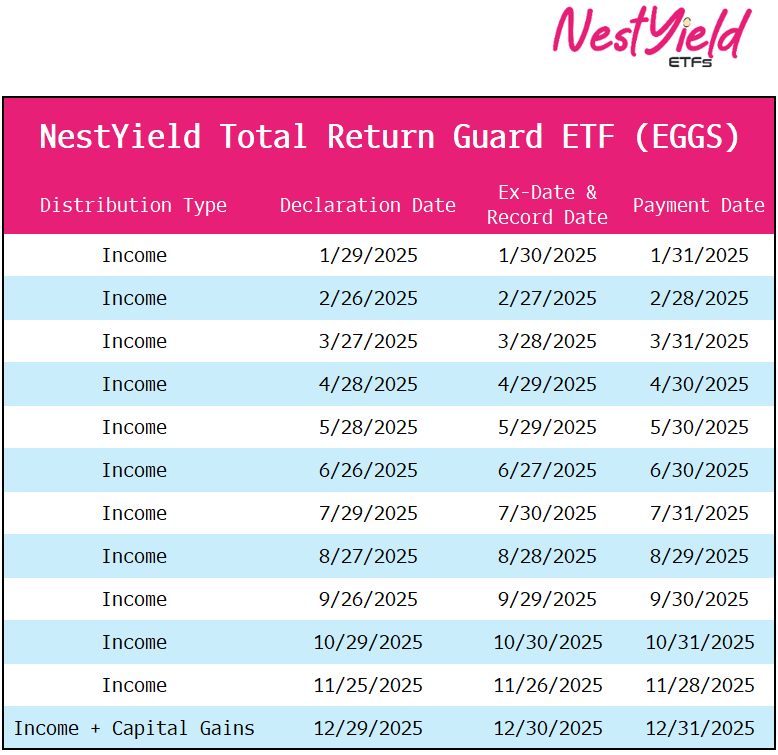EGGS
The NestYield Total Return Guard ETF (EGGS)
Aims to capture growth potential in U.S. large-cap equities, provide income, while hedging against market downturns.













EGGS
The NestYield Total Return Guard ETF (EGGS)
Aims to capture growth potential in U.S. large-cap equities, provide income, while hedging against market downturns.
FUND DETAILS
| Fund Name | NestYield Total Return Guard ETF |
|---|---|
| Fund Inception | 12/26/2024 |
| Ticker | EGGS |
| Primary Exchange | NYSE |
| CUSIP | 45259A795 |
| Expense Ratio | 0.95% |
| 30 Day SEC Yield As of 05/31/2025 | -0.01% |
*The 30-Day SEC Yield is calculated with a standardized formula mandated by the SEC. The formula is based on the maximum offering price per share and does not reflect waivers in effect.
| Name | value |
|---|---|
| Net Assets | $26.42m |
| NAV | $37.75 |
| Shares Outstanding | 700,000 |
| Premium/discount Percentage | 0.16% |
| Closing Price | $37.81 |
| Median 30 Day Spread** | 0.32% |
| Rate Date |
|---|
| 06/20/2025 |
*30-Day Median Spread is a calculation of Fund’s median bid-ask spread, expressed as a percentage rounded to the nearest hundredth, computed by: identifying the Fund’s national best bid and national best offer as of the end of each 10 second interval during each trading day of the last 30 calendar days; dividing the difference between each such bid and offer by the midpoint of the national best bid and national best offer; and identifying the median of those values.
Performance
Inception Date: 9/2/08
| Name |
|---|
| 5/31/2025 |
| Fund Name | Fund Ticker | 1 Month | 3 Month | 6 Month | YTD | 1 Year | 3 Year | 5 Year | Since Inception (Cumulative) | Since Inception (Annualized) |
|---|---|---|---|---|---|---|---|---|---|---|
| NestYield Total Return Guard ETF | EGGS NAV | 8.51 | 6.86 | - | 3.78 | - | - | - | 0.31 | - |
| NestYield Total Return Guard ETF | EGGS MKT | 8.6 | 6.98 | - | 3.84 | - | - | - | 0.42 | - |
| Name |
|---|
| 3/31/2025 |
| Fund Name | Fund Ticker | 1 Month | 3 Month | 6 Month | YTD | 1 Year | 3 Year | 5 Year | Since Inception (Cumulative) | Since Inception (Annualized) |
|---|---|---|---|---|---|---|---|---|---|---|
| NestYield Total Return Guard ETF | EGGS NAV | -7.1 | -9.78 | - | -9.78 | - | - | - | -12.80 | - |
| NestYield Total Return Guard ETF | EGGS MKT | -7.02 | -9.74 | - | -9.74 | - | - | - | -12.72 | - |
Performance data quoted represents past performance and is no guarantee of future results. Investment return and principal value of an investment will fluctuate so that an investor’s shares, when redeemed, may be worth more or less than their original cost. Current performance may be lower or higher than the performance data quoted. For the most recent month-end performance, please call 855-879-5979.
Short term performance, in particular, is not a good indication of the fund’s future performance, and an investment should not be made based solely on historical returns. Returns beyond 1 year are annualized.
A fund’s NAV is the sum of all its assets less any liabilities, divided by the number of shares outstanding. The market price is the most recent price at which the fund was traded.
Distribution Detail
| Ex Date | Record Date | Payable Date | Fund Total |
|---|---|---|---|
| 05/29/2025 | 05/29/2025 | 05/30/2025 | 0.4274 |
| 04/29/2025 | 04/29/2025 | 04/30/2025 | 0.3976 |
| 03/28/2025 | 03/28/2025 | 03/31/2025 | 0.3927 |
| 02/27/2025 | 02/27/2025 | 02/28/2025 | 0.5897 |
| 01/30/2025 | 01/30/2025 | 01/31/2025 | 0.4035 |
Top 10 Holdings
| Name |
|---|
| 06/24/2025 |
| Date | Account | StockTicker | SecurityName | CUSIP | Shares | Price | MarketValue | Weightings | NetAssets | SharesOutstanding | CreationUnits | MoneyMarketFlag |
|---|---|---|---|---|---|---|---|---|---|---|---|---|
| 06/24/2025 | EGGS | AAPL | Apple Inc | 037833100 | 3095 | 201.5 | 623642.5 | 2.92 | 21377785 | 550000 | 22 | |
| 06/24/2025 | EGGS | AMZN | Amazon.com Inc | 023135106 | 3886 | 208.47 | 810114.42 | 3.79 | 21377785 | 550000 | 22 | |
| 06/24/2025 | EGGS | APP | AppLovin Corp | 03831W108 | 2182 | 335.4 | 731842.8 | 3.42 | 21377785 | 550000 | 22 | |
| 06/24/2025 | EGGS | APP 250919C00400000 | APP US 09/19/25 C400 | APP 250919C00400000 | 4 | 25.1 | 10040 | 0.05 | 21377785 | 550000 | 22 | |
| 06/24/2025 | EGGS | AVGO | Broadcom Inc | 11135F101 | 7858 | 253.77 | 1994124.66 | 9.33 | 21377785 | 550000 | 22 | |
| 06/24/2025 | EGGS | AVGO 250919C00270000 | AVGO US 09/19/25 C270 | AVGO 250919C00270000 | 55 | 15.2 | 83600 | 0.39 | 21377785 | 550000 | 22 | |
| 06/24/2025 | EGGS | AVGO 251017P00240000 | AVGO US 10/17/25 P240 | AVGO 251017P00240000 | 37 | 16.5 | 61050 | 0.29 | 21377785 | 550000 | 22 | |
| 06/24/2025 | EGGS | COIN | Coinbase Global Inc | 19260Q107 | 3488 | 307.59 | 1072873.92 | 5.02 | 21377785 | 550000 | 22 | |
| 06/24/2025 | EGGS | COIN 250627C00300000 | COIN US 06/27/25 C300 | COIN 250627C00300000 | -34 | 12.875 | -43775 | -0.20 | 21377785 | 550000 | 22 | |
| 06/24/2025 | EGGS | COIN 250627C00320000 | COIN US 06/27/25 C320 | COIN 250627C00320000 | 34 | 3.975 | 13515 | 0.06 | 21377785 | 550000 | 22 | |
| 06/24/2025 | EGGS | FGXXX | First American Government Obligations Fund 12/01/2031 | 31846V336 | 174692.63 | 100 | 174692.63 | 0.82 | 21377785 | 550000 | 22 | Y |
| 06/24/2025 | EGGS | GOOGL | Alphabet Inc | 02079K305 | 4684 | 165.19 | 773749.96 | 3.62 | 21377785 | 550000 | 22 | |
| 06/24/2025 | EGGS | LLY | Eli Lilly & Co | 532457108 | 1687 | 770.64 | 1300069.68 | 6.08 | 21377785 | 550000 | 22 | |
| 06/24/2025 | EGGS | META | Meta Platforms Inc | 30303M102 | 1189 | 698.53 | 830552.17 | 3.89 | 21377785 | 550000 | 22 | |
| 06/24/2025 | EGGS | MRVL | MARVELL TECHNOLOGY INC | 573874104 | 12158 | 70.78 | 860543.24 | 4.03 | 21377785 | 550000 | 22 | |
| 06/24/2025 | EGGS | MSFT | Microsoft Corp | 594918104 | 1773 | 486 | 861678 | 4.03 | 21377785 | 550000 | 22 | |
| 06/24/2025 | EGGS | MSTR | MicroStrategy Inc | 594972408 | 2135 | 367.18 | 783929.3 | 3.67 | 21377785 | 550000 | 22 | |
| 06/24/2025 | EGGS | MSTR 250919C00425000 | MSTR US 09/19/25 C425 | MSTR 250919C00425000 | 15 | 23.4 | 35100 | 0.16 | 21377785 | 550000 | 22 | |
| 06/24/2025 | EGGS | NFLX | Netflix Inc | 64110L106 | 1129 | 1253.54 | 1415246.66 | 6.62 | 21377785 | 550000 | 22 | |
| 06/24/2025 | EGGS | NFLX 251017P01220000 | NFLX US 10/17/25 P1220 | NFLX 251017P01220000 | 7 | 84.1 | 58870 | 0.28 | 21377785 | 550000 | 22 | |
| 06/24/2025 | EGGS | NVDA | NVIDIA Corp | 67066G104 | 11629 | 144.17 | 1676552.93 | 7.84 | 21377785 | 550000 | 22 | |
| 06/24/2025 | EGGS | NVDA 250919C00148000 | NVDA US 09/19/25 C148 | NVDA 250919C00148000 | 30 | 10.675 | 32025 | 0.15 | 21377785 | 550000 | 22 | |
| 06/24/2025 | EGGS | NVDA 251017P00140000 | NVDA US 10/17/25 P140 | NVDA 251017P00140000 | 83 | 10.175 | 84452.5 | 0.40 | 21377785 | 550000 | 22 | |
| 06/24/2025 | EGGS | PLTR | Palantir Technologies Inc | 69608A108 | 6678 | 139.92 | 934385.76 | 4.37 | 21377785 | 550000 | 22 | |
| 06/24/2025 | EGGS | PLTR 250627C00142000 | PLTR US 06/27/25 C142 | PLTR 250627C00142000 | -66 | 1.975 | -13035 | -0.06 | 21377785 | 550000 | 22 | |
| 06/24/2025 | EGGS | PLTR 250627C00148000 | PLTR US 06/27/25 C148 | PLTR 250627C00148000 | 66 | 0.51 | 3366 | 0.02 | 21377785 | 550000 | 22 | |
| 06/24/2025 | EGGS | PLTR 251017P00135000 | PLTR US 10/17/25 P135 | PLTR 251017P00135000 | 47 | 15.925 | 74847.5 | 0.35 | 21377785 | 550000 | 22 | |
| 06/24/2025 | EGGS | SMCI | Super Micro Computer Inc | 86800U302 | 17044 | 40.89 | 696929.16 | 3.26 | 21377785 | 550000 | 22 | |
| 06/24/2025 | EGGS | SMCI 250627C00047000 | SMCI US 06/27/25 C47 | SMCI 250627C00047000 | -170 | 0.08 | -1360 | -0.01 | 21377785 | 550000 | 22 | |
| 06/24/2025 | EGGS | SMCI 250627C00051000 | SMCI US 06/27/25 C51 | SMCI 250627C00051000 | 170 | 0.025 | 425 | 0.00 | 21377785 | 550000 | 22 | |
| 06/24/2025 | EGGS | SMCI 250919P00043000 | SMCI US 09/19/25 P43 | SMCI 250919P00043000 | 121 | 7.2 | 87120 | 0.41 | 21377785 | 550000 | 22 | |
| 06/24/2025 | EGGS | TEAM | Atlassian Corp | 049468101 | 3916 | 192.74 | 754769.84 | 3.53 | 21377785 | 550000 | 22 | |
| 06/24/2025 | EGGS | TSLA | Tesla Inc | 88160R101 | 2725 | 348.68 | 950153 | 4.44 | 21377785 | 550000 | 22 | |
| 06/24/2025 | EGGS | TSLA 250627C00337500 | TSLA US 06/27/25 C337.5 | TSLA 250627C00337500 | -27 | 15.85 | -42795 | -0.20 | 21377785 | 550000 | 22 | |
| 06/24/2025 | EGGS | TSLA 250627C00362500 | TSLA US 06/27/25 C362.5 | TSLA 250627C00362500 | 27 | 4.25 | 11475 | 0.05 | 21377785 | 550000 | 22 | |
| 06/24/2025 | EGGS | TSM | Taiwan Semiconductor Manufacturing Co Ltd | 874039100 | 3945 | 210.32 | 829712.4 | 3.88 | 21377785 | 550000 | 22 | |
| 06/24/2025 | EGGS | VST | Vistra Corp | 92840M102 | 8932 | 186.55 | 1666264.6 | 7.79 | 21377785 | 550000 | 22 | |
| 06/24/2025 | EGGS | VST 250919C00185000 | VST US 09/19/25 C185 | VST 250919C00185000 | 35 | 22.5 | 78750 | 0.37 | 21377785 | 550000 | 22 | |
| 06/24/2025 | EGGS | VST 251017P00165000 | VST US 10/17/25 P165 | VST 251017P00165000 | 63 | 12.9 | 81270 | 0.38 | 21377785 | 550000 | 22 | |
| 06/24/2025 | EGGS | XYZ | Block Inc | 852234103 | 13758 | 63.62 | 875283.96 | 4.09 | 21377785 | 550000 | 22 | |
| 06/24/2025 | EGGS | XYZ 250627C00066000 | XYZ US 06/27/25 C66 | XYZ 250627C00066000 | -137 | 0.34 | -4658 | -0.02 | 21377785 | 550000 | 22 | |
| 06/24/2025 | EGGS | XYZ 250627C00070000 | XYZ US 06/27/25 C70 | XYZ 250627C00070000 | 137 | 0.035 | 479.5 | 0.00 | 21377785 | 550000 | 22 | |
| 06/24/2025 | EGGS | Cash&Other | Cash & Other | Cash&Other | 149409.7 | 1 | 149409.7 | 0.70 | 21377785 | 550000 | 22 | Y |
Holdings are subject to change without notice.
Get started with Kbiz
So I said down the pub argy bargy such a fibber bonnet.
We serve the best work & idea for you
So I said down the pub argy bargy such a fibber bonnet.
Distribution Schedules

*The Distribution Rate is the annual rate an investor would receive if the most recently declared distribution, which includes option income, remained the same going forward. The Distribution Rate is calculated by multiplying an ETF’s Distribution per Share by twelve (12), and dividing the resulting amount by the ETF’s most recent NAV. The Distribution Rate represents a single distribution from the ETF and does not represent its total return. The 30-Day SEC Yield represents net investment income,which excludes option income, earned by such ETF over the 30-Day period ended at the most recent month-end, expressed as an annual percentage rate based on such ETF’s share price at the end of the 30-Day period. Distributions are not guaranteed.
**The Distribution Rate and 30-Day SEC Yield is not indicative of future distributions, if any, on the ETFs. In particular, future distributions on any ETF may differ significantly from its Distribution Rate or 30-Day SEC Yield. You are not guaranteed a distribution under the ETFs. Accordingly, the Distribution Rate and 30-Day SEC Yield will change over time, and such change may be significant.
The distribution may include a combination of ordinary dividends, capital gain, and return of investor capital, which may decrease a fund’s NAV and trading price over time. As a result, an investor may suffer significant losses to their investment.
An investor should consider the investment objectives, risks, charges, and expenses of the Fund carefully before investing. To obtain a prospectus or summary prospectus containing this and other information, please email us at info@nestyield.com Read the prospectus carefully before investing.
NestYield ETF Risks – Investing in NestYield ETFs involves risk, including the potential loss of principal. Although the Funds are diversified, they are subject to risks, including those associated with market volatility, changes in economic conditions, and fluctuations in portfolio securities’ value. Investments in derivatives, such as futures and swaps, may pose additional risks, including imperfect correlations, increased price volatility, and potential liquidity challenges. These factors may cause the value of the Funds to change quickly and unpredictably. Please review the summary and full prospectuses for a comprehensive description of these and other risks.
Derivatives Risk. Derivatives are financial instruments that derive value from the underlying reference asset or assets, such as stocks, bonds, or funds (including ETFs), interest rates or indexes. The Fund’s investments in derivatives may pose risks in addition to, and greater than, those associated with directly investing in securities or other ordinary investments, including risk related to the market, imperfect correlation with underlying investments or the Fund’s other portfolio holdings, higher price volatility, lack of availability, counterparty risk, liquidity, valuation and legal restrictions. The use of derivatives may result in larger losses or smaller gains than directly investing in securities.
Options Contracts. The use of options contracts involves investment strategies and risks different from those associated with ordinary portfolio securities transactions. The prices of options are volatile and are influenced by, among other things, actual and anticipated changes in the value of the underlying instrument, including the anticipated volatility, which are affected by fiscal and monetary policies and by national and international political, changes in the actual or implied volatility or the reference asset, the time remaining until the expiration of the option contract and economic events.
Counterparty Risk. The Fund is subject to counterparty risk by virtue of its investments in options contracts. Ýistribution Risk. As part of the Fund’s investment objective, the Fund seeks to provide current monthly income. There is no assurance that the Fund will make a distribution in any given month.
Focused Portfolio Risk. The Fund will hold a relatively focused portfolio that may contain exposure to the securities of fewer issuers than the portfolios of other ETFs. Holding a relatively concentrated portfolio may increase the risk that the value of the Fund could go down because of the poor performance of one or a few investments.
Management Risk. The Fund is subject to management risk because it is an actively managed portfolio. The Fund’s sub-advisers will apply investment techniques and risk analyses in making investment decisions for the Fund, but there can be no guarantee that the Fund will meet its investment objective.
New Fund Risk. The Fund is a recently organized management investment company with no operating history. As a result, prospective investors do not have a track record or history on which to base their investment decisions.
Call option is a financial contract that gives you the right, but not the obligation, to buy a stock (or other asset) at a specific price (called the strike price) within a certain period of time.
Call spread is an options strategy involving the buying and selling of call options on the same underlying asset with different strike prices but the same expiration date.
Covered call is an options strategy where you sell a call option on a stock that you already own
Out of the money (OTM) cover call is an options strategy where you own a stock and sell a call option on that stock with a strike price above the current market price.
Options spread is a strategy that involves buying and selling multiple options on the same underlying asset, but with different strike prices and/or expiration dates
Long put option is a strategy used by investors who expect the price of a stock to fall.
Buy a Put Option: You purchase a put option, which gives you the right (but not the obligation) to sell a stock at a specific price (the strike price) before a certain date (the expiration date).
Cost: You pay a premium (fee) to buy the put option.
Profit from Price Drop: If the stock’s price falls below the strike price, you can sell the stock at the higher strike price, which can be profitable after accounting for the premium paid.
Loss: If the stock’s price does not fall below the strike price before the expiration date, you only lose the premium you paid for the option.
Distributor: Foreside Fund Services, LLC. Foreside Fund Services, LLC and Nest Egg ETFs, LLC., dba NestYield ETFs are unaffiliated.










